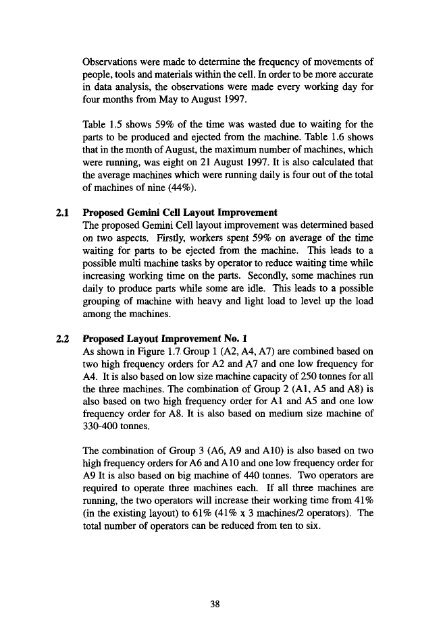(jit) principles and systematic layout planning as tools to improve ...
(jit) principles and systematic layout planning as tools to improve ...
(jit) principles and systematic layout planning as tools to improve ...
Create successful ePaper yourself
Turn your PDF publications into a flip-book with our unique Google optimized e-Paper software.
Observations were made <strong>to</strong> determine the frequency of movements of<br />
people, <strong><strong>to</strong>ols</strong> <strong>and</strong> materials within the cell. In order <strong>to</strong> be more accurate<br />
in data analysis, the observations were made every working day for<br />
four months from May <strong>to</strong> August 1997.<br />
Table 1.5 shows 59% of the time w<strong>as</strong> w<strong>as</strong>ted due <strong>to</strong> waiting for the<br />
parts <strong>to</strong> be produced <strong>and</strong> ejected from the machine. Table 1.6 shows<br />
that in the month of August, the maximum number of machines, which<br />
were running, w<strong>as</strong> eight on 21 August 1997. It is also calculated that<br />
the average machines which were running daily is four out of the <strong>to</strong>tal<br />
of machines of nine (44%).<br />
2.1 Proposed Gemini Cell Layout Improvement<br />
The proposed Gemini Cell <strong>layout</strong> <strong>improve</strong>ment w<strong>as</strong> determined b<strong>as</strong>ed<br />
on two <strong>as</strong>pects. Firstly, workers spent 59% on average of the time<br />
waiting for parts <strong>to</strong> be ejected from the machine. This leads <strong>to</strong> a<br />
possible multi machine t<strong>as</strong>ks by opera<strong>to</strong>r <strong>to</strong> reduce waiting time while<br />
incre<strong>as</strong>ing working time on the parts. Secondly, some machines run<br />
daily <strong>to</strong> produce parts while some are idle. This leads <strong>to</strong> a possible<br />
grouping of machine with heavy <strong>and</strong> light load <strong>to</strong> level up the load<br />
among the machines.<br />
2.2 Proposed Layout Improvement No. 1<br />
As shown in Figure 1.7. Group 1 (A2, A4, A7) are combined b<strong>as</strong>ed on<br />
two high frequency orders for A2 <strong>and</strong> A7 <strong>and</strong> one low frequency for<br />
A4. It is also b<strong>as</strong>ed on low size machine capacity of 250 <strong>to</strong>nnes for all<br />
the three machines. The combination of Group 2 (Al, A5 <strong>and</strong> A8) is<br />
also b<strong>as</strong>ed on two high frequency order for Al <strong>and</strong> A5 <strong>and</strong> one low<br />
frequency order for A8. It is also b<strong>as</strong>ed on medium size machine of<br />
330-400 <strong>to</strong>nnes.<br />
The combination of Group 3 (A6, A9 <strong>and</strong> A10) is also b<strong>as</strong>ed on two<br />
high frequency orders for A6 <strong>and</strong> A10 <strong>and</strong> one low frequency order for<br />
A9 It is also b<strong>as</strong>ed on big machine of 440 <strong>to</strong>nnes. Two opera<strong>to</strong>rs are<br />
required <strong>to</strong> operate three machines each. If all three machines are<br />
running, the two opera<strong>to</strong>rs will incre<strong>as</strong>e their working time from 41%<br />
(in the existing <strong>layout</strong>) <strong>to</strong>61%(41%x3 machines/2 opera<strong>to</strong>rs). The<br />
<strong>to</strong>tal number of opera<strong>to</strong>rs can be reduced from ten <strong>to</strong> six.<br />
38


